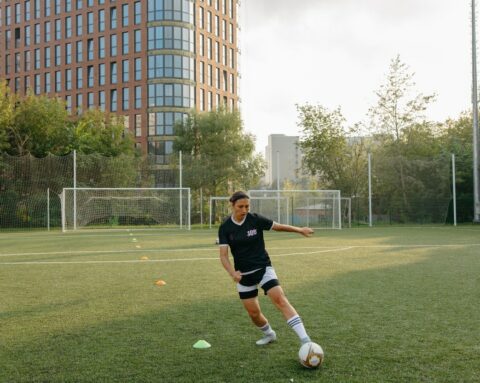Your shoulder offers a huge range of motion, strength and mobility. This does however come with a drawback to the level of stability. The cause of shoulder dislocation or subluxation usually occurs as a result of either shoulder joint instability or as a result of sudden trauma.
You may experience a dislocated shoulder when the ball of your upper arm bone is forced from its position in the socket of the shoulder. This injury is usually extremely painful and will make it so that you are unable to move your arm until the ball of your upper arm is placed back into the socket. In some cases, a shoulder subluxation can occur which refers to a partially dislodged shoulder.
Symptoms And Causes:
A shoulder being traumatically popped out is the typical sign that the shoulder is dislocated. If your shoulder does not completely leave the joint, it is most likely partially subluxated.
A shoulder dislocation carries many commons symptoms as well as displaying deformities. These include; sensation of the shoulder losing feeling or slipping in and out, pins and needs, weakness of the arm, shoulder pain and repeated instances of the shoulder giving way.
The third common cause of shoulder dislocations is known as Repetitive Shoulder Ligament Overstrain. People who have looser ligaments in their shoulders may experience a dislocation with relative ease. This instability can be part of your natural anatomy or it can occur as a result of over-stretching often due to sport. Some sports that can cause your shoulder ligaments to overstretch are tennis, volleyball, cricket or swimming. It is important to always check with your myotherapist for advice on your specific situation.
If your shoulder is in a vulnerable position at a point of impact whilst at speed it may be popped out as a “high speed’ or “traumatic shoulder” dislocation. This scenario is commonly seen in a rugby tackle or if you fall. A multi-directional instability shoulder dislocation is usually caused due to your genetics. In this situation, your shoulder may be unstable in multi directions and feel loose or become dislocated repeatedly. People who experience this, generally have loose ligaments and are potentially hyper-mobile or double-jointed.
Treatment:
Your myotherapist will first discuss your injury history and shoulder symptoms with you. Following this, your myotherapist will examine the shoulder to search for signs of instability. Usually, the diagnosis will be confirmed either in the clinic or the field of play.
In some cases, your myotherapist may require further imaging tests such as X-Rays or MRI to determine your diagnosis. If you have any questions about your shoulder please ask your shoulder myotherapist.
Phase 1:
Some extra treatment options are available to you during your dislocated shoulder recovery: The first is the use of a shoulder sling which is the main treatment used particularly in the first few weeks after the dislocation occurs. Other options include Kinesio tape and the use of a shoulder brace.
Whilst these options may not prevent further dislocations, they do provide mild to moderate support which is useful in the early stages of treatment.
Shoulder dislocations, be they repeated or acute are usually treated with non-operative rehabilitation which is closely monitored by your myotherapist. If your initial non-operative based treatment does not show results then surgery may be considered for stabilisation purposes.
In the first phase of your shoulder dislocation recovery, your myotherapist will ensure that your nerves and blood supply are not compromised. It is important to head to the hospital to check for possible fractures which may require an x-ray.
Phase 2:
Phase 2 of your shoulder dislocation recovery will focus on managing your pain. It is very common to experience quite intense pain when moving your shoulder in the early days of your injury.
Your myotherapist or doctor will usually provide you with a sling to immobilise and support your shoulder. Overstretching is to be avoided for between two to six weeks. In phase two it is crucial to manage the inflammation of your shoulder via ice and to rest as much as possible.
There is a range of tools at your myotherapists disposal to reduce your inflammation and pain such as electrotherapy, acupuncture, soft tissue massage and taping techniques that may be required in this stage of your recovery.
Phase 3:
The strength of your shoulders rotator cuff muscles and scapular stabilisers must be maintained in stage 3 of your recovery. Your rotator cuff muscles are crucial to dynamically stabilise your shoulder joint.
As your scapular attaches your arm to the chest wall it also requires stability. The scapular provides a crucial base that, if not functioning, can allow your shoulder to slide into a position that is more likely to dislocate in the future. As always your myotherapist will assess your situation and prescribe the best possible treatment and exercise regime for you!
Phase 4:
In phase 4 your myotherapist will ensure the restoration of your natural range of motion and posture. In this stage, your inflammation and pain will begin to ease and your ligaments will start the healing process.
Some treatment methods that may be employed during this stage are massage, stretches, acupuncture, dry needling, joint mobilisation and alignment techniques. Your myotherapist will ensure that the best techniques are used for your situation to avoid reinjury or predisposition to a future dislocation.
Phase 5:
Stage five of your shoulder dislocation recovery is where you will begin to return to your usual activities! Your treatment in this phase will be specific to your required level of activity and load that will be placed on the shoulder.
This can be from something as simple as carrying shopping bags or as complex as heavy weight lifting. Whatever the situation your myotherapist will ensure that your treatment is right for you.
Phase 6:
It is quite common for a shoulder dislocation to recur in poorly recovered shoulders. As a result, phase 6 of your recovery will focus on ensuring that any deficiencies are addressed and that your shoulder biomechanics are correct.
In this stage of the treatment, your myotherapist may provide you with scapular, posture or rotator cuff exercises to improve your biomechanics. You will notice your shoulder stability being enhanced with speed and agility drills which will ensure you can return to sport safely!
Return To Sport and Recovery Outlook:
When you first dislocate your shoulder, it may likely recur especially in young people. Whilst recurrence lowers as you age, for people under 25 it is around 80%. Your myotherapist will focus on reducing the possibility of recurrent dislocation. This may involve the use of a sling for the first 2-3 weeks to reduce the recurrence rate.
Your return to sport will be observed on an individual basis, however, the usual time to return to athletic activity is a minimum of 6-8 weeks and it is more likely to be a period of 3 months.
Surgical Options and Stabilisation:
It can sometimes be necessary to stabilise your shoulder with surgery to repair overstretched or torn ligaments and prevent future dislocations. If you undergo surgery the chances of a recurrent dislocation are as low as around 5%.
Your myotherapist will speak with your doctor and conclude whether you are a candidate for a surgical procedure following your non-operative treatment.






